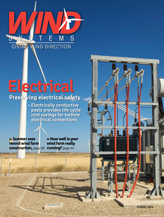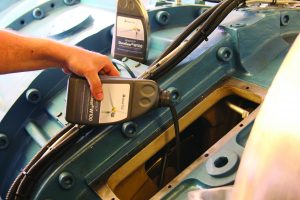The 2015 edition of NFPA 70E is due for publication in October, and with it will be many changes that will affect wind farm safety requirements. NFPA 70E forms the basis for most electrical safety programs, but it can be confusing when the standard is updated regarding what has actually changed. There are many more changes than can be covered in this article due to space constraints, but I can review a few. I will be revising my pocket guide, “Significant Changes to NFPA 70E — 2015 Edition,” published by American Technical Publishers (go2ATP.com). Also, please note that this article does not attempt to provide a formal interpretation of NFPA 70E. To receive a formal interpretation, please contact NFPA directly.
Outlined below are some changes to Chapter 1 of NFPA 70E.
SECTION 130.2(A)(4)
One of the issues the 70E Committee has addressed over the last three cycles is that of operating electrical equipment, and working near electrical equipment that is in operation. In the 2012 edition of NFPA 70E, Section 130.(7)(a) IN No. 2 was added, stating:
It is the collective experience of the Technical Committee on Electrical Safety in the Workplace that normal operation of enclosed electrical equipment, operating at 600 volts or less, that has been properly installed and maintained by qualified persons is not likely to expose the employee to an electrical hazard.
This Informational Note explains that normal operation of equipment that has been properly installed and maintained is not likely to pose an increased arc flash risk. The key to this statement is “not likely.” “Not likely” does not mean “never,” nor does it imply that personal protection equipment (PPE) is not required under all circumstances. Qualified persons will still have to assess the risks involved in performing any task and dress out accordingly. This is true whether the PPE Category Tables are used or Arc Flash Hazard Warning Labels. Turn the autopilot to the OFF position.
That being said, there still seemed to be some confusion in the industry. In an attempt to bring more clarity to the committee’s intent, 130.2.(A)(4) was added:
Normal operation of electric equipment is permitted when all of the following conditions are satisfied:
• The equipment is properly installed;
• The equipment is properly maintained;
• All equipment doors are closed and secured;
• All equipment covers are in place and secured; and
• There is no evidence of impending failure.
The inclusion of 130.2(A)(4) should make clear that it is not the intent of the Technical Committee to force the wearing of arc-rated clothing and PPE to operate an electrical device in the manner specified by the manufacturer. That being said, the Technical Committee would encourage workers to wear such PPE and clothing whenever that worker believes it might be needed or is more comfortable wearing such equipment.
As an example, if I were about to operate a 480 V circuit breaker with a continuous current rating above ~1,000A I would dress out on HRC 2 PPE and arc-rated clothing. It should also be noted that “normal operation” means to operate the equipment in the manner specified by the manufacturer. If the manufacturer states that a push button must be used to operate the equipment, operation by any other means would be outside the scope of this statement and it would not apply.
Section 130.2(A)(4) includes an Informational Note that explains what is meant by “properly installed” and “properly maintained”:
Informational Note: The phrase “properly installed” means that the equipment is installed in accordance with applicable industry codes and standards and the manufacturer’s recommendations. The phrase “properly maintained” means that the equipment has been maintained in accordance with the manufacturer’s recommendations and applicable industry codes and standards. The phrase “evidence of impending failure” means that there is evidence such as arcing, overheating, loose or bound equipment parts, visible damage, or deterioration.”
This is the first time these terms have been defined in NFPA 70E and provides a basis for determining equipment condition.
SECTION 130.4(B)
The 70E Committee has been trying to make the 70E more user-friendly. To meet that goal, the committee has worked to clarify and simplify the 70E.
One such effort was to eliminate the Prohibited Approach Boundary by looking at the way the shock approach boundaries are used in the field. The Limited Approach and Restricted Approach Boundaries both are triggers for certain actions.
The Limited Approach Boundary is the closest an unqualified person can approach exposed energized conductors or circuit parts and the Restricted Approach Boundary is the point at which a qualified person must wear insulating rubber gloves or take other action to protect themselves from the shock hazard.
The Prohibited Approach Boundary contained no such trigger and people in general seemed to be confused as to its purpose.
SECTION 130.5(B)
The requirements for labeling of electrical equipment have been a point of confusion for the last cycle or two. Part of the reason was the 2009 edition of NFPA 70E only stated that electrical equipment had to be labeled. This led some to believe that anything electrical had to be labeled.
The wording in the 2015 edition should clarify exactly what the intent is. It states:
Electrical equipment such as switchboards, panelboards, industrial control panels, meter socket enclosures, and motor control centers that are in other than dwelling units and that are likely to require examination, adjustment, servicing, or maintenance while energized shall be field-marked with a label containing all the following information:
(1) Nominal system voltage
(2) Arc flash boundary
(3) At least one of the following:
a. Available incident energy and the corresponding working distance
b. Minimum arc rating of clothing
c. Site—specific level of PPE
d. PPE category in 130.7(C)(15)(b) or 130.7(C)(15)(d) for the equipment.
Only equipment that may require inspections, adjustment, servicing or maintenance while energized are required to have the field marking (label) in place. If the equipment does not require inspection, adjustment, servicing or maintenance while energized, it does not require the label.
Section 130.5(B) also states:
Exception: Labels applied prior to September 30, 2011, are acceptable if they contain the available incident energy or required level of PPE.”
The method of calculating and the data to support the information for the label shall be documented.
Where the review of the arc flash hazard risk assessment identifies a change that renders the label inaccurate, the label shall be updated.
The owner of the electrical equipment shall be responsible for the documentation, installation, and maintenance of the field-marked label. [emphasis added]
The emphasized portions of the above two paragraphs show the added requirements for 2015. If the label becomes inaccurate for any reason, it must be updated to reflect the current requirements for that piece of equipment. It also states that the equipment owner is the person responsible for the required labels. The owner does not have to personally install or maintain the labels, but he is responsible to see that it is done.
NEW ARC FLASH PPE TABLES 130.7(C)(15)(a) and (b)
The NFPA 70E technical committee has agreed to a new format for choosing arc-rated clothing and PPE. Table 130.7(C)(15)(a) will be split into two tables. The first table is used to determine if an arc flash hazard exists. One of the complaints about the current table method is that tasks that do not pose an arc flash hazard are listed in the table, such as operating a panelboard meter.
If no arc flash hazard exists, why have that task in the table? The answer is that in using the old table method, all tasks common to that equipment were listed to ensure workers knew that some tasks were not an arc flash hazard. It is somewhat clumsy and confusing. The HRC for a category of equipment could be down-rated by one, two or even three numbers, based on perceived risk.
Under the new table method, no such reduction is used. If there is an arc flash hazard, you must wear all the required PPE and clothing.
Table 1 shows a portion of the proposed table for the 2015 NFPA 70E. No arc flash hazard means nothing further is required. If there is an arc flash hazard, then you would move to a second (added) table and choose the arc flash category of the recommended clothing and PPE. This is based on the same limits as the current table and the categories remain the same. The difference is that there is no risk factored in. Risk is still a factor, but now the level of risk is determined by conducting a risk assessment for that specific task on that specific piece of equipment, but only for tasks that pose an arc flash hazard.
Note that in the added table there is no perceived arc flash hazard if the equipment is properly installed, properly maintained and there is no evidence of impending failure on some of the listed tasks. This is critical, as these factors have to be part of the risk assessment required by NFPA 70E. If a worker is troubleshooting electrical equipment, it is no longer normally operating; it is in distress and arc flash protective equipment must be worn to operate it or perform any other task on or with it. If an arc flash hazard is present, the second new table is used to determine arc-rated clothing and PPE. Table 2 shows a portion of the proposed new table.
HRC 0 was eliminated, as the committee felt that this table should only show requirements where arc-rated clothing was required. HRC 0 would mean the worker was outside the arc flash boundary and did not need arc-rated PPE or clothing. Section 130.7(C)(11) states, “Clothing consisting of fabrics, zipper tapes, and findings made from flammable synthetic materials that melt at temperatures below 315°C (600°F), such as acetate, acrylic, nylon, polyester, polyethylene, polypropylene, and spandex, either alone or in blends, shall not be used.” This section as well as section 130.7(C)(12) prohibit the wearing of meltable fabrics.
The category of the arc-rated clothing and PPE is still determined by the type of equipment and has the same limits, but is no longer task-based. The arc flash boundaries (AFB) are rounded up to the nearest foot (except for PPE Category 1) and working distances are the same as in the current table.
Risk is removed as a determining factor in the table, although risk must be determined by the user. PPE Category 1 was stated in inches, as rounding up caused a conflict with the requirement that “all parts of the body inside the Arc Flash Boundary (AFB) must be protected”. At 24” the back of the head would probably be within the AFB and the worker would have to wear an arc-rated balaclava.
Summary
The 70E continues to improve with each cycle. The Technical Committee wants to have a standard that is usable, easy to interpret and will provide a means to guide technicians and electricians to establishing a safe work environment.
There is some disagreement within the committee about how the 70E should fulfill that role. Should it represent “best safe work practices” or should it provide “minimum acceptable guidelines”?
I fall into the “minimum acceptable guidelines” group. A qualified person should be able to assess the hazards and risks involved in performing the task at hand and also be able to assess equipment condition. If they are unable to perform those requirements, they should not be considered a qualified person and require additional training.
I don’t believe the 70E should attempt to provide “best safety work practices,” because it is not practical for the committee to properly evaluate and establish specific when there are so many variables.
Qualified persons must be able to perform their personal evaluations based on site and equipment conditions at the time of the task being performed.
A standard cannot address that situation, and should not attempt to do so.


































